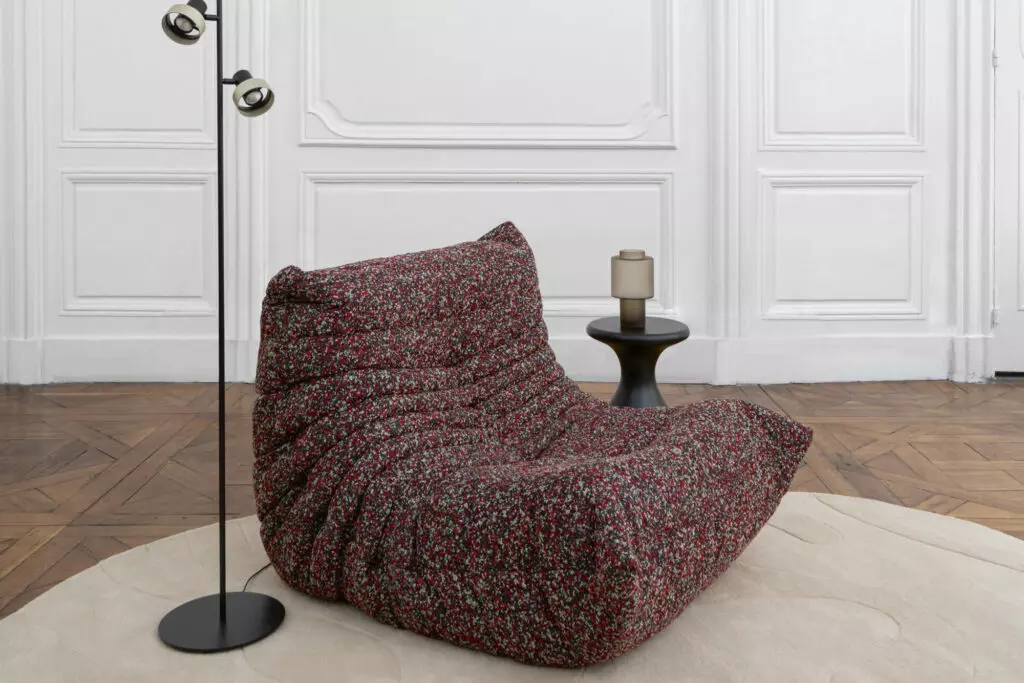An atom, the most basic building block of chemistry, balances protons and electrons. The Atom, a new twist on the TOGO chair from French furniture company Ligne Roset, balances form and function. Created to celebrate the prize-winning chair’s 50th anniversary, this latest iteration of the design puts a patterned spin on the deep curves, tufted corners, and striking aesthetic appeal of the original. And, in another atomic parallel, the TOGO created an explosive turning point in furniture history when it was revealed half a century ago; a big glamorous bang that blew up all existing expectations of interior design. Not familiar with the story? Here’s the quick version.
A Revolutionary Chair that Redefined Interior Design
When it debuted in 1973, the TOGO turned some serious heads. Innovative and utterly different, the chair was conceived by Michel Ducaroy, the then-head of Ligne Roset’s design department, during a time of tremendous change for the furniture company. Ducaroy's vision and creativity revolutionized the way people looked at furniture.
The late 1960s saw Ducaroy and his pioneering presence in the design world bring about a cultural crescendo of sorts. New materials including high-quality foams and polyester quilting were being developed, and the brand’s customer base was part of an emerging, progressive generation with a reputation for playful taste and a laissez-faire approach to social norms. This, paired with the increasingly revered Ligne Roset name, meant Ducaroy was afforded more and more chances to experiment — as he did at 1973’s Salon des arts ménagers in Paris.
The Birth of Iconic Design
It was at the Salon des arts ménagers that Ducaroy and Ligne Roset debuted the TOGO chair, which immediately caught the attention of design enthusiasts. This boundary-pushing chair won the René-Gabriel Prize for its revolutionary looks. But its cultural impact went far beyond the design world. As the hippie movement gained momentum and became a subculture, Ducaroy's distinctive designs found favor with a younger audience, captivating them with their modern materials and innovative techniques. Ducaroy's finger was firmly on the pulse of this new generation.
Versatility and Whimsy Meet Comfort
The unique design of the TOGO chair invited a variety of interpretations, but its most defining characteristic was its versatility. Like a tulip petal, the TOGO curved up from top to bottom. Its ribbed fabric compressed to form a cozy seat that was both idiosyncratic and inviting. With its ability to effortlessly blend into any environment, the TOGO added a touch of whimsy to minimalist, mid-century settings.
 Image: Ligne Roset TOGO Chair 50th anniversary in white
Image: Ligne Roset TOGO Chair 50th anniversary in white
A 50th Birthday Celebration with an Atomic Twist
As the TOGO chair celebrates its 50th birthday, it does so with the Atom pattern. Designed by Belgian fashion designer Raf Simons, the Atom pattern pays homage to the experimental roots of the TOGO. The bouclé fabric with its pointillist-inspired specks adds a palpable energy to the iconic design. This limited-edition TOGO, available in three colors (birch, labradorite, and confetti), is a stirring tribute to the original chair. It combines modern materials and coordinated chaos, capturing the essence of the explosive, disruptive design that made the TOGO a timeless icon.
 Image: Ligne Roset TOGO Chair atom edition for 50th anniversary in red
Image: Ligne Roset TOGO Chair atom edition for 50th anniversary in red
In conclusion, the TOGO chair's 50-year journey is one of innovation, creativity, and design excellence. It has stood the test of time, redefining interior design and captivating the hearts of design enthusiasts worldwide. With its latest Atom pattern iteration, the TOGO chair continues to push boundaries and inspire new generations. It remains a true icon that balances form and function, just like an atom balances protons and electrons.

















